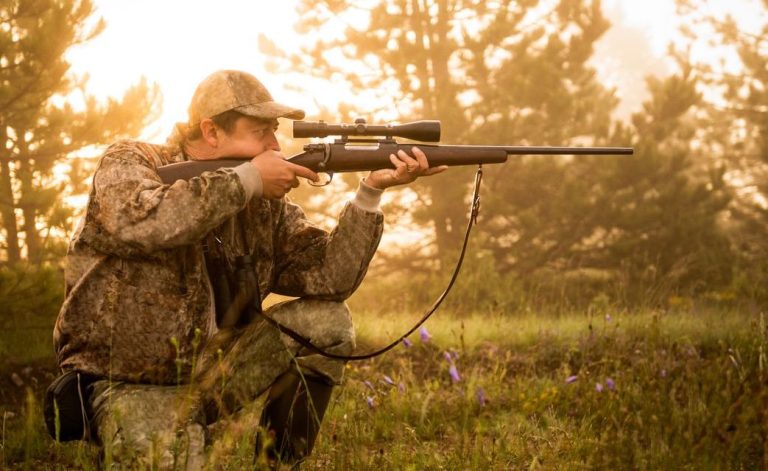Choosing the best rifle scope is no longer just about spending more for better quality—it’s about understanding what meets your hunting or shooting needs. Over the past decade, competition among optics manufacturers has skyrocketed, driving innovation and stabilizing prices. Today, you can find exceptional options across all price ranges, from budget-friendly to high-end scopes. Whether you’re a casual deer hunter or a long-range precision shooter, this guide explores the best rifle scopes of to date, detailing features, pros, and cons to help you make an informed decision. While it seems like most things are getting more expensive these days, the cost of the best rifle scopes has stayed relatively stable for the past decade or more. What has changed, however, is the quality. As more manufacturers get into the lucrative optics market, competition increases, causing prices to stabilize but quality to increase. There was a time when the difference between bargain scopes and mid-range scopes was clear, pardon the pun, but nowadays, that line gets more blurred. There are some great rifle scopes that will more than serve the needs of the average deer hunter, in that $300-$500 range and you can get into some more specialized long-range optics for under a $1,000 these days. Even the top names like Zeiss, Swarovski and Leica have base models that start around $1,000 and they come with all the quality associated with these brands.
A decade ago, when you walked down the aisles of SHOT Show, every second booth seemed to be a new optics manufacturer. The truth was, most were being made in China and the Philippines in the same plants and being badged with whatever manufacturer’s name was paying for that run that day. Most were crap but as typically happens, the more legitimate scope companies have survived, while hundreds of others have disappeared. We are at a good place in the optics industry right now; there are lots of great choices out there, even for the most budget-conscious user. There was an old adage that said you should pay more for your scope than your rifle but as rifle prices have risen, that rule no longer applies. Now, it’s possible to pay half the price of a rifle or less and still be well-equipped. Let’s take a look at some of the best rifle scopes on the market today.
In case you came here looking for a specific case scenario, I’ve placed the winners as follows. Click each rifle scope to be taken to why it was chosen, its pros, its cons, and the best place to purchase.
- Best Overall – Zeiss Conquest V4 4-16×44
- Best Thermal Riflescope – Pulsar Thermion 2 XP50 Pro
- Best Mid-Range – Meopta Optika 6 3-18×50 BDC-3 Illuminated SFP
- Best Under $1,000 – Riton 5 Primal 2-12×44 IR
- Best Under $500 – Vortex Diamondback 3-9×40
- Best Value – Maven CRS.1 3-12×40
- Best Electronic/Rangefinding – Burris Eliminator 6 4-20×52
- Best For Whitetails – Athlon Midas HMR 2.5-15×50
- Best Rifle Scope for Turkey – Hawke Vantage IR 1-4×20
- Best Red Dot for AR 15 – Aimpoint Comp 5
- Best Value Long Range Riflescope – Bushnell Match Pro ED 3-18×50
- Best Lightweight Riflescope – Swarovski Z3 3-9×36
- Best For Lever Guns – Leupold VX-Freedom 1.5-4×28 IER Scout Duplex
Best Overall – Zeiss Conquest V4 4-16×44
| Purchase Options: (click to shop) | Amazon |
| Scheels | |
| Optics Planet |
 To come out on top in this category, a scope needs to be as at home in the mountains of the west as it is in the deer woods of the east. It needs to be fairly lightweight, but it needs to have enough magnification and MOA adjustment for those longer shots often faced by mountain hunters. It needs to have a means of ballistic compensation and should have quality lenses that are bright and clear, even in the shoulder hours of the day. This scope needs to provide exceptional value for the price
To come out on top in this category, a scope needs to be as at home in the mountains of the west as it is in the deer woods of the east. It needs to be fairly lightweight, but it needs to have enough magnification and MOA adjustment for those longer shots often faced by mountain hunters. It needs to have a means of ballistic compensation and should have quality lenses that are bright and clear, even in the shoulder hours of the day. This scope needs to provide exceptional value for the price
Zeiss introduced their Conquest line in 2014 as mid range line of scopes, and it continues to be their line of workhorse scope hunting scopes. Currently, the Conquest line features the V6, with six times zoom range, and the V4 with four times zoom range. I run the V4 on several of my rifles and for the money, I don’t believe you can buy a better all-round scope. I’ve taken my V4 on several overseas hunts and it’s my go to scope here in the foothills and mountains of Alberta.
I don’t believe you will find clearer lenses with better light transmission in this price range. While rating light transmission is a bit of a moving target, Zeiss calculates theirs based on the light passing through all lenses in the scope. Many other manufacturers base theirs on light transmission through a single lens, so you are not always comparing apples to apples when talking light transmission. The V4 boats an impressive 90% light transmission, only 5% less than their top end line of Victory HT scopes. To put it simply, during legal light hunting conditions in most states and provinces, you will never be wishing for more light, even with the modest 44mm objective lens. It is also available with a 50mm objective lens but the 44 has never left me wishing for more and it keeps the weight and physical size down, a desired trait on a mountain rifle.
The Zeiss V4 boasts an impressive 80 MOA of elevation adjustment, allowing for shots in excess of 800 yards with moderate velocity cartridges. I shoot the V4 with a Zplex reticle and the exposed MOA elevation turret allows for easy elevation adjustment. The elevation adjustment on the V4 tracks perfectly and the zero stop ensures it always returns precisely to zero. The V4 also offers side parallax adjustment but the windage turret is capped and does not allow for external adjustment. The V4 doesn’t have all the bells and whistles of a dedicated long-range scope but for an all-round scope for the hunter that keep shots in the 10–500-yard range, it’s perfect.
Pros
- 30mm tube
- Second-Focal plane
- Exposed ¼” elevation turret
- Zero stop on elevation turret
- 80 MOA elevation adjustment range
- Side parallax adjustment
- Four times zoom range
- LotuTec coating on lenses
- 90% light transmission
- Lightweight at 22.6 ounces
- Illuminated reticle available
Cons
- Zplex reticle is a bit coarse for target shooting and extreme long range
- No external windage turret
Best Mid-Range – Meopta Optika 6 3-18×50 BDC-3 Illuminated SFP
| Purchase Options: (click to shop) | Euro Optic |
| Sport Optics |
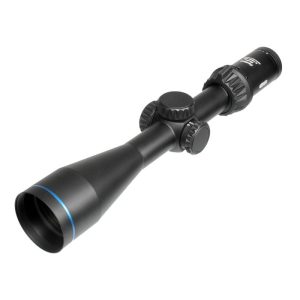 The mid-range category looks at scopes in the $500-$800 and in my mind, these are the scopes that have seen the most improvement in the past decade without drastic price increases. There were a lot of candidates for this title, so don’t panic if your favorite mid-range scope isn’t here, as the competition was neck and neck but, in the end, we picked the Meopta Optika6 3-18×50. While Meopta may not be a household name in North America, this Czechoslovakian company has been in the optics business since 1933 and established itself in North America as Meopta USA, Inc in 2005. Since then, it’s been offering North Americans quality optics at a fair price.
The mid-range category looks at scopes in the $500-$800 and in my mind, these are the scopes that have seen the most improvement in the past decade without drastic price increases. There were a lot of candidates for this title, so don’t panic if your favorite mid-range scope isn’t here, as the competition was neck and neck but, in the end, we picked the Meopta Optika6 3-18×50. While Meopta may not be a household name in North America, this Czechoslovakian company has been in the optics business since 1933 and established itself in North America as Meopta USA, Inc in 2005. Since then, it’s been offering North Americans quality optics at a fair price.
The Optika6 is their mid range line of hunting scopes, and it offers a very generous six times zoom range, so it is well suited to those wanting to take longer range shots. For a scope in this price range, it offers an impressive 88% light transmission. It is offered with a wide variety of reticles, both in first and second focal plane. For the winner in this category, we chose the second focal plane BDC reticle, primarily for simplicity of use in a hunting situation. The one negative is that only the first focal place scopes have external elevation turrets, so you are solely reliant on the BDC reticle for long-range shots. It does, however, offer side parallax adjustment and has a generous four-inch eye relief. It doesn’t have all the features of the higher end scopes but for the serious hunter on a budget, it is sure to please.
I had the opportunity to shoot this scope at a range day this summer and will admit to being impressed with how bright it appeared for a scope in this price range.
Pros
- 30mm tube
- Second-plane with first focal plane option
- Illuminated red dot in reticle
- Side parallax adjustment
- Six times zoom range
- MeoBright 5501 coating on lenses
- 88% light transmission
Cons
- Only five hashmarks on BDC reticle
- No external windage turret
- No on-line calculator for reticle
- Heavy at 30 ounces
Best Under $1,000 – Riton 5 Primal 2-12×44 IR
| Purchase Options: (click to shop) | Amazon |
| Optics Planet |
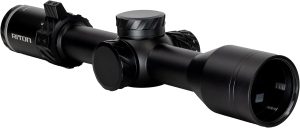 I’d never shot a Riton Optics’ rifle scope until this past summer, when I was introduced to them at a range day held for outdoor writers, near Edmonton, Alberta. The company was founded in 2013 by a U.S. Air Force veteran and is based in Tucson, Arizona. The Riton 5 line is manufactured in Japan, which automatically puts in on a higher level than those from China in my books. And after shooting it for a while, there was little doubt that you were shooting a quality made scope. For under $1,000 it has excellent clarity and light transmission and offers that very desirable six times zoom range. It has a very generous 90 MOA of elevation adjustment and it left me wondering why it didn’t have an external elevation turret to take advantage of it. When I shot the scope, we removed the cap to check the tracking, and it was true and shot well out to 500 yards and returned perfectly to zero.
I’d never shot a Riton Optics’ rifle scope until this past summer, when I was introduced to them at a range day held for outdoor writers, near Edmonton, Alberta. The company was founded in 2013 by a U.S. Air Force veteran and is based in Tucson, Arizona. The Riton 5 line is manufactured in Japan, which automatically puts in on a higher level than those from China in my books. And after shooting it for a while, there was little doubt that you were shooting a quality made scope. For under $1,000 it has excellent clarity and light transmission and offers that very desirable six times zoom range. It has a very generous 90 MOA of elevation adjustment and it left me wondering why it didn’t have an external elevation turret to take advantage of it. When I shot the scope, we removed the cap to check the tracking, and it was true and shot well out to 500 yards and returned perfectly to zero.
To win this category, lens quality must be at the highest standard and Riton didn’t disappoint. Their HD lenses are rated at 99.5% light transmission for an individual lens, but they don’t offer an overall light transmission rating for all the lenses combined but I’d say it would hold up well with the higher-end scopes in that $1,000 range. I’m a fan of more compact scopes and appreciated the 44mm objective lens and with the lens quality, saw no need for a 50mm. I quite liked the illuminated reticle in this scope as well. It has six illumination levels, depending on time of the day. It was also quite fine at the point of aim, which was nice when shooting paper, as it gave a more precise point of aim. Overall, the Riton 5 Primal 2-12×44 IR would be a great addition to a higher end hunting rifle that was going to see use primarily in the heavy woods but could easily handle shots to 300 yards in more open areas. For the hunter that just wants a scope with great glass and no gadgets, the Riton 5 Primal 2-12×44 IR fits the bill perfectly.
Pros
- 30mm tube
- Illuminated red dot in reticle
- Side parallax adjustment
- Six times zoom range
- 90 MOA of elevation adjustment
- Waterproof coating on lenses
- HD lenses
- Flip up lens covers included
Cons
- No external elevation turret
- Relatively heavy at 27 ounces
- Only 3.5 inches of eye relief
Best Under $500 – Vortex Diamondback 3-9×40
| Purchase Options: (click to shop) | Amazon |
| Scheels | |
| Optics Planet |
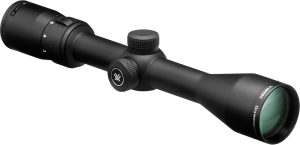 This category is aimed at the casual big game hunter who gets out to hunt primarily on weekends and isn’t interested in shooting longer ranges. I definitely don’t fall into this category but after trying several scopes in this category, I must admit to being impressed at what you could get for under $500 bucks. Sure, they don’t compare to the mid-range and more expensive scopes when it comes to lens quality and light transmission, but they are pretty functional and hold zero well.
This category is aimed at the casual big game hunter who gets out to hunt primarily on weekends and isn’t interested in shooting longer ranges. I definitely don’t fall into this category but after trying several scopes in this category, I must admit to being impressed at what you could get for under $500 bucks. Sure, they don’t compare to the mid-range and more expensive scopes when it comes to lens quality and light transmission, but they are pretty functional and hold zero well.
Vortex has been a name long associated with quality, lower cost scopes. More recently, they have produced a number of higher-end models, but their bread and butter are still in the under $500 category. Most shooters were first attracted to the brand by their lifetime, no-fault warranty, but many have stayed with them for the value they offer. Many first-time gun owners start out with a Diamondback on their rifle, and for those that never get too serious about hunting or shooting, they remain there. This is not said to knock the hunters or the product, but just to point out that our investment in the sport is often proportional to the degree of involvement, and it’s refreshing to see this kind of quality in this price range.
With only a three-times zoom range, the Diamondback doesn’t require the increased room for the internal mechanics that larger zoom-range optics require, so it features a one-inch main tube. With only a 40mm objective lens and lower quality lenses and coatings than higher-end models, don’t expect exceptional low-light performance, but from the time I’ve spent behind this scope, it is more than adequate for legal hunting hours in most jurisdictions. Don’t forget this is a budget scope but it does offer excellent performance when compared to other scopes in its class. The BDC reticle does offer three additional holdover points as well for taking longer shots, but I definitely wouldn’t call this a good option for longer-range shooting. For the casual deer hunter who never takes a shot over 300 yards, it’s definitely worth a look.
Pros
- BDC reticle
- 70 MOA of elevation adjustment
- Anti-glare coating on lenses
- Lightweight at only 14.4 ounces
- Low glare, matte finish
- Lifetime warranty
Cons
- One-inch main tube
- 40mm objective lens
- Reliability issues
- Only 3.3 inches of eye relief.
Best Value – Maven CRS.1 3-12×40
| Purchase Options: (click to shop) | Amazon |
| Maven |
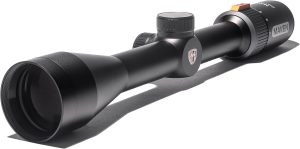 In this category, we looked at scopes that offered the most value when considering features and optical quality and the Maven CRS.1 3-12×50 is packed with features typically reserved for higher-end scopes. These scopes feature Japanese lenses, and the quality is obvious when you look through this scope. The four-times zoom range is welcome and Maven has included a ballistic reticle in the scope and there is a handy on-line calculator to determine the values of the secondary hashmarks. While I wouldn’t say this is great choice for long-range shooting, it is more than capable out to 500 yards, especially with the 12-times magnification at the top end.
In this category, we looked at scopes that offered the most value when considering features and optical quality and the Maven CRS.1 3-12×50 is packed with features typically reserved for higher-end scopes. These scopes feature Japanese lenses, and the quality is obvious when you look through this scope. The four-times zoom range is welcome and Maven has included a ballistic reticle in the scope and there is a handy on-line calculator to determine the values of the secondary hashmarks. While I wouldn’t say this is great choice for long-range shooting, it is more than capable out to 500 yards, especially with the 12-times magnification at the top end.
Maven has an interesting philosophy in that they do not sell through retailers but rather sell direct online. While they claim this does keep cost down, it does not give their brand much awareness nor does it give hunters an opportunity to try it out before purchasing. Maven does, however, offer an opportunity to buy the scope and if you aren’t happy with it, you can return it within two weeks for a full refund. You’re just out the shipping.
This scope features everything the hunter in the eastern or western part of the country really needs, with no extra bells and whistles to drive up the cost. It does everything it needs to do for around $500. I particularly like the raised index bar for changing magnification. Even with thick gloves on, it’s easy to turn. It’s a simple thing but shows how well thought out this scope really is. It even comes with its own neoprene scope cover. The only thing that would have made this scope better in my mind, would be a 44mm objective lens to let more light in when using the top end of magnification.
Pros
- BDC reticle with online calculator
- Anti glare coating on lenses
- Lightweight at only 14.18 ounces
- 3.7 inches of eye relief
- Lifetime warranty
Cons
- One-inch main tube
- 40mm objective lens
- Only 50 MOA of elevation adjustment
- Not available at retailers
Best Bargain – Riton 3 Primal 3-9×40 EER
| Purchase Options: (click to shop) | Amazon |
| Riton |
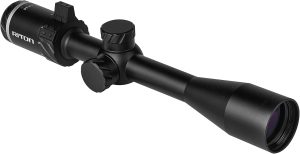 A decade ago, I would have told you not to waste your money on a $250 scope for a centerfire rifle but the Riton 3 Primal 3-9×40 EER definitely punches about its weight. Don’t expect anything fancy here but this is definitely a great option for the casual hunter or shooter. The EER stands for extended eye relief, making this a viable option for lever guns, shotguns, crossbows and AR-style rifles. It has a very generous five inches of eye relief. Make no mistake, this is an entry-level scope but a good option for someone on a tight budget just getting into hunting or just wanting to do some plinking. It comes with a simple duplex reticle and capped turrets so it’s not a long-range scope but for those not wanting to shoot over a couple hundred yards, it’s worth a look.
A decade ago, I would have told you not to waste your money on a $250 scope for a centerfire rifle but the Riton 3 Primal 3-9×40 EER definitely punches about its weight. Don’t expect anything fancy here but this is definitely a great option for the casual hunter or shooter. The EER stands for extended eye relief, making this a viable option for lever guns, shotguns, crossbows and AR-style rifles. It has a very generous five inches of eye relief. Make no mistake, this is an entry-level scope but a good option for someone on a tight budget just getting into hunting or just wanting to do some plinking. It comes with a simple duplex reticle and capped turrets so it’s not a long-range scope but for those not wanting to shoot over a couple hundred yards, it’s worth a look.
It tracks true on both the elevation and windage turrets, with each click representing .25 inch. And for a scope in this price range, it has an impressive 80 MOA of elevation adjustment. Parallax is fixed at 100 yards, and it weighs in at a modest 22.5 ounces. The thumb lever on the magnification ring is a nice addition, making dialing through the range of zoom a breeze. This scope actually compares pretty well to some other scopes costing twice as much and for those looking for an inexpensive scope, the Riton 3 Primal 3-9×40 EER is worthy of consideration.
Pros
- Moderate weight at 22.5 ounces
- Five inches of eye relief
- Lifetime warranty
- Excellent entry-level scope
Cons
- One-inch main tube
- 40mm objective lens
Best Electronic/Rangefinding – Burris Eliminator 6 4-20×52
| Purchase Options: (click to shop) | Amazon |
| Scheels | |
| Optics Planet |
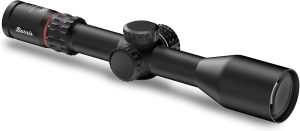 I was introduced to the original Burris Eliminator in 2010 at a range day and was underwhelmed to say the least. It was bulky, the lens quality was questionable, and the calculated aim points weren’t all that accurate downrange on the target. The laser rangefinder in the scope maxed out at around 500 yards and the controls were awkward to use. My first experience with the Eliminator pretty well caused me to discount the next four versions in the subsequent 14 years. But the new Burris Eliminator 6 4-20x52mm definitely caught my attention. Like the original Eliminator, it has a built-in rangefinder that illuminates the correct point of aim in the reticle for the shooting distance but that’s where the similarities end.
I was introduced to the original Burris Eliminator in 2010 at a range day and was underwhelmed to say the least. It was bulky, the lens quality was questionable, and the calculated aim points weren’t all that accurate downrange on the target. The laser rangefinder in the scope maxed out at around 500 yards and the controls were awkward to use. My first experience with the Eliminator pretty well caused me to discount the next four versions in the subsequent 14 years. But the new Burris Eliminator 6 4-20x52mm definitely caught my attention. Like the original Eliminator, it has a built-in rangefinder that illuminates the correct point of aim in the reticle for the shooting distance but that’s where the similarities end.
First, it looks like a regular rifle scope. Burris has eliminated a lot of the bulk and mounting issues and the optical quality is much improved. It’s not what you’d expect in a $3,000 regular rifle scope but you are paying for the electronics in the new Eliminator and the lens quality is adequate. The nice thing too, is that if your batteries happen to die or you suffer an electronic issue, the new Eliminator can be used just like a regular scope.
At the heart of the Eliminator 6 is a built-in rangefinder that seem reliable out to around 800 yards on a deer when the rifle is on a steady rest. The scope features a built-in thermometer, barometer, and inclinometer and wind speed and direction can be manually input, and that value is saved until manually changed. At first glance the reticle will give you a case of vertigo but it’s actually pretty simple. It’s Christmas tree configuration of black dots and the only one you need to worry about is the one that’s illuminated after measuring the range and inputting wind speed and direction. The illuminated dot is your point of hold for the measured range and environmental conditions. There is a regular reticle that can be used without the assistance of electronics. This is a nice option when a close shot presents itself and there is no need for ranging.
The scope is customized to each load you shoot, through the use of an APP on your phone. You do need to know the muzzle velocity of your load for it to be accurate. Unlike the original Eliminator that was a nightmare to program, The Eliminator 6 is pretty simple. Once the data is input for your load, shooting simply requires the press of a button to range, and the scope calculates the rest, illuminating the point of aim in seconds.
Pros
- 34mm main tube
- Adjustable parallax
- Built in rangefinder
- Built in ballistic compensation
- Easy to use app
- 1/8 MOA elevation and windage turrets
- Can be used without electronics in the event of battery failure
Cons
- Heavy at 30 ounces
- Optical quality could be better
- 3.4 inch eye relief
Best Rifle Scope For Whitetails – Athlon Midas HMR 2.5-15×50
| Purchase Options: (click to shop) | Amazon |
| Scheels | |
| Optics Planet |
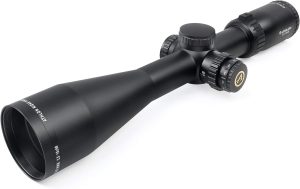
For those in the eastern part of the country, they may question why we chose such a high magnification scope and large objective lens for whitetail hunting but hear me out. Whitetails live in the west as well and often present shots at ranges in excess of 400 yards in less-than-ideal light conditions. As this category was best for whitetails, we felt that needed to include hunters east and west. For those in the east hunting the heavier woods, you’ll appreciate the low end 2.5 magnification on the Athlon Midas HMR 2.5-15×50.
For around $600, this scope has a lot of features typically only found on higher end scopes and the HD lens quality is definitely impressive. The six times zoom range is a surprise on a scope in this price range but a necessity of a dedicated whitetail scope that needs to be just as at home in the thick woods as it is in the open plains. It also features an easy to use illuminated ballistic BDC reticle and side parallax adjustment. This is a true 500-yard scope in capable hands.
While Athlon may not be a household name in the optics world, they celebrated their 10th year in business in 2024 and are earning a reputation for quality mid range optics. This is a lot of scope for the money and Athlon does offer a lifetime warranty.
Pros
- 30mm main tube
- Adjustable parallax
- BDC reticle
- Six times zoom range
- 3.9-inch eye relief
Cons
- A bit heavy at 26 ounces
- No on-line calculator for reticle
Best For Dangerous Game – Trijicon Credo HX 1-8×28
| Purchase Options: (click to shop) | Amazon |
| Scheels | |
| Optics Planet |
![]() My days of using iron sights are behind me and I require a scoped rifle these days when hunting dangerous game like cape buffalo or even grizzly here in North America. A dangerous-game scope should be compact and have a lower end magnification around 1x, but it’s ideal if you can dial up to 6 or even 8x when the rifle is to double for plains game. I think an illuminated reticle is a must as well, as it aids in rapid target acquisition. The Trijicon Credo HX 1-8×28 meets all these criteria and more.
My days of using iron sights are behind me and I require a scoped rifle these days when hunting dangerous game like cape buffalo or even grizzly here in North America. A dangerous-game scope should be compact and have a lower end magnification around 1x, but it’s ideal if you can dial up to 6 or even 8x when the rifle is to double for plains game. I think an illuminated reticle is a must as well, as it aids in rapid target acquisition. The Trijicon Credo HX 1-8×28 meets all these criteria and more.
For a $1,900 scope, the Credo HX doesn’t disappoint when it comes to lens quality and even with only a 28mm objective lens, this scope is bright and clear, even in low light situations. The scope has an impressive eight-times zoom range, from 1-8 power and exposed, locking elevation and windage turrets allow you to stretch out the ranges for plains game. The reticle can illuminate in either red or green, depending on the conditions and its unique design really focuses the eye right to the center of it, a desirable trait when hunting dangerous game in the thick cover.
With a maximum eye relief of four inches, the Credo HX is right at home on the heaviest magnum rifles and a robust 34mm main tube ensures there is plenty of surface for the rings to grip. I like the lever on the magnification ring as well as it allows rapid adjustment should conditions require. A dangerous game scope needs to be simple and complex all in the same package and Trijicon hit that balance with the Credo HX 1-8×28
Pros
- 34mm tube
- Exposed, locking elevation and windage turrets
- Side parallax adjustment
- Eight times zoom range
- Illuminated reticle available
- Maximum four-inch eye relief
Cons
- Only one reticle option
- Moderate weight at 25.6 ounces
Best Rifle Scope for Turkey – Hawke Vantage IR 1-4×20
| Purchase Options: (click to shop) | Amazon |
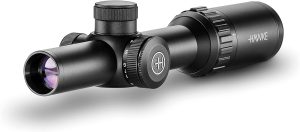 Where legal, many turkey hunters are electing to outfit their shotguns with a scope to aid in more precise aiming. This is especially true for those of us with aging eyesight who struggle with iron or even glo-type sights. I’m the first to admit that my days of using open sights are over and a scoped shotgun is my go-to for turkey hunting these days. A shotgun scope doesn’t need to be anything fancy, and honestly, the simpler, the better.
Where legal, many turkey hunters are electing to outfit their shotguns with a scope to aid in more precise aiming. This is especially true for those of us with aging eyesight who struggle with iron or even glo-type sights. I’m the first to admit that my days of using open sights are over and a scoped shotgun is my go-to for turkey hunting these days. A shotgun scope doesn’t need to be anything fancy, and honestly, the simpler, the better.
The Hawke Vantage IR 1-4×20 with turkey dot reticle is ideal and for around $250, it’s not going to break the bank for a scope you use only a few days out of the year. Hawke’s new Turkey Dot IR reticle ensures fast acquisition and can be switched between red and green depending on conditions and preference. The illuminated center dot is surrounded by an illuminated horseshoe that measures 10 inches at 50 yards, when on 4x magnification. The reticle also has five illumination levels.
This is a no nonsense dedicated turkey scope. Parallax is fixed at 50 yards, and it has a crude .5 MOA per click on the turrets, but you really don’t need to fine-tune your point of aim any more than that when sending a load of pellets downrange. It has a fairly generous field of view, something to consider when turkey hunting and a full four inches of eye relief so you don’t get scoped when shooting the big 3.5-inch magnum shells. A slightly larger objective lens would have made this scope brighter but overall, it’s all you need for a turkey scope.
Pros
- Four times zoom range
- Illuminated turkey reticle
- Four-inch eye relief
- Good field of view
- Extremely lightweight at 11.7 ounces
Cons
- One inch tube
- 20mm objective lens
Best For the West – Leica Amplus 6 3-18×44
| Purchase Options: (click to shop) | Optics Planet |
| Amazon |
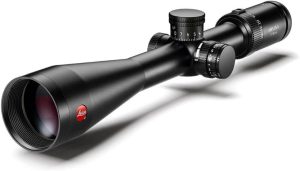 As western hunters are typically packing lighter-weight rifles and often faced with longer-range shots, their scopes need to be capable of making those shots without weighing the rifle down. The Leica Amplus 6 3-18×44, fits the bill perfectly. Leica is well known for their high quality optics, and this scope doesn’t disappoint despite the modest price tag of around $1,400. The lenses are clear and crisp right to the edges and with a true 90% light transmission, the 44mm objective lens helps keep weight down while still letting in plenty of light during the shoulder shooting hours. The six-times zoom range is ideal when hunting in the heavy timber or in the wide-open spaces of the mountains.
As western hunters are typically packing lighter-weight rifles and often faced with longer-range shots, their scopes need to be capable of making those shots without weighing the rifle down. The Leica Amplus 6 3-18×44, fits the bill perfectly. Leica is well known for their high quality optics, and this scope doesn’t disappoint despite the modest price tag of around $1,400. The lenses are clear and crisp right to the edges and with a true 90% light transmission, the 44mm objective lens helps keep weight down while still letting in plenty of light during the shoulder shooting hours. The six-times zoom range is ideal when hunting in the heavy timber or in the wide-open spaces of the mountains.
The Leica Amplus 6 3-18×44 comes with an exposed elevation turret but no windage turret. It does also come with a ballistic reticle with windage compensation on it. Many hunters like this for the speed and ease of use but it does limit fine tuning for windage at extreme ranges. The reticle also features an illuminated dot in the center. This is a second focal plane scope, so the ballistic reticle is used at full magnification. The scope also features an adjustable side parallax. It has a generous 80 MOA of elevation adjustment, making this scope capable of some long shots.
Leica offers a pretty limited number of models compared to other manufacturers and definitely had the western hunter in mind with the Amplus 6 3-18×44. For a scope of this quality with six times zoom and all the other features it boasts, the price tag is pretty attractive.
Pros
- 30mm tube
- Second-plane
- Exposed ¼” elevation turret
- Zero stop on elevation turret
- 80 MOA elevation adjustment range
- Side parallax adjustment
- Six times zoom range
- Lightweight at 23.6 ounces
- Illuminated reticle
Cons
- Only one reticle option
- No external windage turret
Best Precision First Focal Plane Target – Zeiss LRP S5 5-25×56
| Purchase Options: (click to shop) | Amazon |
| Scheels | |
| Optics Planet |
 A couple of years ago Zeiss wouldn’t even have rated a mention in this category but when they decided to get into this arena, they did it in style. I got my hands on one of these scopes last year and had an opportunity to put it through its paces. The first thing you’ll notice is how bright and crisp the lenses are. There’s no doubt you are looking through quality German glass and with a price tag of around $4,000 it should be that good. The internal mechanics require a 34mm main tube to accommodate the six-times zoom range and the massive 140 MOA of elevation adjustment. This is a true one-mile scope. This scope was designed for PRS and NRL type competitions and blows away most of the competition when it comes to optical quality.
A couple of years ago Zeiss wouldn’t even have rated a mention in this category but when they decided to get into this arena, they did it in style. I got my hands on one of these scopes last year and had an opportunity to put it through its paces. The first thing you’ll notice is how bright and crisp the lenses are. There’s no doubt you are looking through quality German glass and with a price tag of around $4,000 it should be that good. The internal mechanics require a 34mm main tube to accommodate the six-times zoom range and the massive 140 MOA of elevation adjustment. This is a true one-mile scope. This scope was designed for PRS and NRL type competitions and blows away most of the competition when it comes to optical quality.
The is Zeiss’ first foray back into first focal plane scopes for several decades. While they were competitive in most other shooting and hunting disciplines, they had nothing for the precision target market and the LRP line was several years in development. It has locking elevation and windage turrets as well as two ballistic reticle option, MOA and MR. Each style has their fan club, and each will argue the virtues of their choice, so Zeiss made is easy by offering both. Zeiss has been a leader in reticle design and according to many top-rated shooters, they hit the balance perfectly here of not making it overly complicated but still incorporating all the features necessary to be competitive. It also features an adjustable side parallax.
There’s really nothing not to like about this scope other than perhaps they could have had .125 MOA clicks on the turrets rather than .25, to allow for finer adjustment at extreme ranges. Zeiss really did their homework with this scope and competitive shooters are embracing it.
Pros
- 34mm tube
- First-Focal Plane
- Exposed/locking elevation and windage turrets
- Zero stop on elevation turret
- 140 MOA elevation adjustment range
- Side parallax adjustment
- Five times zoom range
- 90% light transmission
- MOA and MR reticle options
Cons
- .25 MOA adjustment
- Heavy at 36.3 ounces
- Scope is a bit bulky
Best Second-Focal Plane Long-Range Hunting – Night Force NXS 5.5-22×50
| Purchase Options: (click to shop) | Amazon |
| Optics Planet |
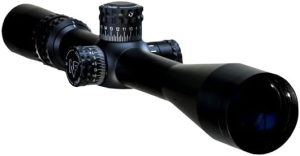 Night Force has long been associated with quality long-range scopes and got their start making scopes for the military but soon found favor in the hunting and precision shooting arenas. They’ve always been noted for good optical quality but definitely not in the same league as the big three, Swarovski, Leica and Zeiss. What they are noted for, however, is durability and repeatability in long-range shooting, and the NXS 5.5-22×50 is a great example of this. This is a precision second-focal plane scope that offers 100 MOA of elevation adjustment, with each click being a precise .25 MOA.
Night Force has long been associated with quality long-range scopes and got their start making scopes for the military but soon found favor in the hunting and precision shooting arenas. They’ve always been noted for good optical quality but definitely not in the same league as the big three, Swarovski, Leica and Zeiss. What they are noted for, however, is durability and repeatability in long-range shooting, and the NXS 5.5-22×50 is a great example of this. This is a precision second-focal plane scope that offers 100 MOA of elevation adjustment, with each click being a precise .25 MOA.
The scope features both elevation and windage turrets and a side parallax adjustment. The elevation turret has a zero stop to prevent dialing down past zero. There are also two ballistic reticle options and for hunting purposes, the new MOAR-T is a good option. It features .0625 MOA lines, with 1 MOA elevation and windage markings. While Nightforce suggests the reticle can also be used for range finding, virtually all long-range hunters today are utilizing a laser rangefinder for much greater precision. On this second focal plane scope, the ballistic reticle can only be used repeatably at maximum magnification and the excellent turrets on the scope are a far more efficient means of ballistic compensation. The MOA marks on the horizontal line of the reticle are handy though for quick wind compensation. At nearly two pounds, this is a beast of a scope and not likely to find its way onto a light-weight mountain rifle but for elk and mule deer hunters, it’s a great option.
Pros
- 30mm tube
- Second-Focal Plane
- Exposed elevation and windage turrets
- Zero stop on elevation turret
- 100 MOA elevation adjustment range
- Side parallax adjustment
- Five times zoom range
Cons
- .25 MOA adjustment
- Heavy at 31 ounces
Best Red Dot for AR 15 – Aimpoint Comp 5
| Purchase Options: (click to shop) | Amazon |
| Optics Planet |
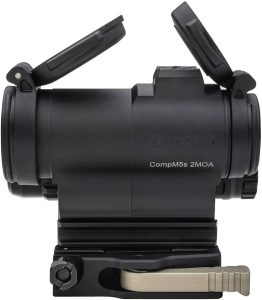 Red dot style scopes, or reflex sights, as they are often called, are becoming extremely popular on rifles like the AR15, which are often used at closer ranges and require fast target acquisition. As the name implies, the sight utilizes a single LED red dot as the aim point, and it stays on target no matter what your eye alignment is. The size of the dot is measured in MOA. Simply put, a 3 MOA dot would cover roughly a three-inch circle at 100 yards. So obviously, the smaller the dot, the more precise it is but when things are happening fast and rapid target acquisition is required, larger dots can be advantageous.
Red dot style scopes, or reflex sights, as they are often called, are becoming extremely popular on rifles like the AR15, which are often used at closer ranges and require fast target acquisition. As the name implies, the sight utilizes a single LED red dot as the aim point, and it stays on target no matter what your eye alignment is. The size of the dot is measured in MOA. Simply put, a 3 MOA dot would cover roughly a three-inch circle at 100 yards. So obviously, the smaller the dot, the more precise it is but when things are happening fast and rapid target acquisition is required, larger dots can be advantageous.
The Aimpoint Comp 5 is an AR-ready version that comes standard with a 39mm spacer and a quick-release mount for a Picatinny rail. It is a true one-power scope, with a 2 MOA red dot but it can accept Aimpoint 3x and 6x magnifiers and all night vision devices, making it an extremely versatile scope for hunting. The red dot has 10 brightness settings for use at all hours of the day. This is a great option for varmint hunting with your AR. The sight boasts an impressive battery life of over 50,000 hours of constant use with one AAA battery. That’s over five years of use. The only odd thing about this sight and I suspect it is related its military applications, is that the elevation and windage adjustment is in millimeters rather than inches or MOA. One click equals 10mm at 100 yards or roughly .4 inches. It’s fairly coarse adjustment but this sight is designed for use at close range, so it’s not a huge factor.
The Comp 5 can also be used with both eyes open, when situational awareness is required. Whether you are looking for a home defence option or something to night hunt predators with, this lightweight, rugged sight will serve you well.
Pros
- 50,000-hour battery life
- 6 Daytime and 4 nighttime brightness settings
- Can be paired with magnifiers and night vision
- Can be used with both eyes open
- Precision 2 MOA red dot
- Weighs only 5.2 oz
- Unlimited eye relief
Cons
- Relatively expensive at around $1,150
- Turrets are in millimeters rather than MOA
Best Value Long Range Rifle Scope – Bushnell Match Pro ED 3-18×50
| Purchase Options: (click to shop) | Bushnell |
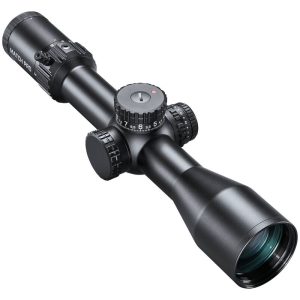 Bushnell, once a leader in mid-range optics, seemed to go in a strange direction after being acquired by Alliant Techsystems in 2013. They dropped many of their most popular lines of rifle scopes and lost a lot of ground to up-and-coming Vortex. While their lines of scopes still seem a bit confusing, their Match Pro ED 5-30×56 Riflescope, introduced in 2023, caught the attention of budget-minded competition shooters. Bushnell followed in 2024 with the more compact Match Pro ED 3-18×50, still aimed primarily at competition shooters but the long-range hunting crowd is taking notice. With a retail price of around $750, this scope has a lot of features found on scopes costing twice as much.
Bushnell, once a leader in mid-range optics, seemed to go in a strange direction after being acquired by Alliant Techsystems in 2013. They dropped many of their most popular lines of rifle scopes and lost a lot of ground to up-and-coming Vortex. While their lines of scopes still seem a bit confusing, their Match Pro ED 5-30×56 Riflescope, introduced in 2023, caught the attention of budget-minded competition shooters. Bushnell followed in 2024 with the more compact Match Pro ED 3-18×50, still aimed primarily at competition shooters but the long-range hunting crowd is taking notice. With a retail price of around $750, this scope has a lot of features found on scopes costing twice as much.
It’s built on a 34mm main tube and has the very desirable six-times zoom range, making it at home in the heavier timber and in the open plains of the west. The Extra-Low Dispersion Prime objective lens provides surprising clarity for a scope in this price range. This is a first-focal plane scope as well, so the MIL 2 Reticle remains constant through all magnification powers. The 2/10 MRAD tree reticle is illuminated and offers 11 brightness settings and shuts off automatically after five minutes of no movement. It functions just like a red dot with shake-awake and may be turned off manually. While this reticle is well designed for competition, it is far too complicated for hunting applications, in my opinion, and I’m not a fan of total reticle illumination on a hunting scope, but I much prefer a small, illuminated dot or cross in the center. Hopefully, future models will offer a more hunting-friendly reticle option.
The Match Pro ED also offers an external MRAD elevation turret with a revolution indicator to dial up for the longer shots and it has a zero stop. The windage turret is capped. Hopefully, we will see an MOA elevation turret as an option for hunting applications in the future. The side parallax adjustment focuses all the way down to 15 yards. It has a handy level on the magnification ring that can be moved for either left or right-handed shooters. The scope offers 40 MRAD or around 89 MOA of elevation adjustment, with each click being 1/10 MRAD.
This scope was obviously built with competition in mind, and it is feature-packed for the price and great entry-level scope that you can be instantly competitive with. hopefully, we will see an MOA hunting version in the near future. Bushnell seems to be woefully lacking when it comes to higher-end hunting optics, and with a couple of minor changes, this could get them back into that market.
Pros
- 34mm tube
- First-Focal Plane
- Exposed elevation turret with revolution indicator and zero stop
- 40 MRAD of elevation adjustment range
- Side parallax adjustment
- Six times zoom range
- Surprisingly light at 28 oz.
Cons
- Reticle overly complicated
- Only available in MRAD configuration
- Full reticle illumination
Best Lightweight Rifle Scope – Swarovski Z3 3-9×36
| Purchase Options: (click to shop) | Amazon |
| Scheels |
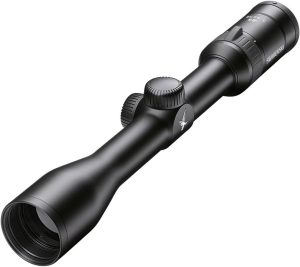
As scopes go to higher-quality lenses and more internal mechanisms, the trade-off is increased weight. It’s hard to find a quality, extremely lightweight rifle scope these days that is at home on an ultra-light mountain rifle, but the Swarovski Z3 3-9×36 fits the bill perfectly. Now before you go off pointing out all the features this scope doesn’t have, let’s not forget that each feature adds ounces. This scope comes in at a scant 12 ounces. This is a basic hunting scope with a one-inch tube and no means of ballistic compensation. It’s offered with either a traditional plex or the more European style 4A reticle with thicker posts only on the bottom and sides. It boasts an impressive 90% light transmission which is needed with the 36mm objective lens during the shoulder hours. It has an ample 3.74 inches of eye relief for heavier recoil rifles.
This looks like your grandfather’s scope from the ‘60s, and other than having modern Swarovski lenses and coatings and precision elevation and windage adjustment, it’s really not that different. This is a no-nonsense scope designed for lightweight rifles or for those who just want to enjoy great glass on their rifle without any bells and whistles. I can’t really say anything bad about this scope as it is what it is, other than it could benefit from a rudimentary ballistic reticle. But if you want a quality lightweight scope, the Swarovski Z3 3-9×36 fills that need perfectly.
Pros
- Super lightweight at only 12 ounces
- Quality lenses and coatings
Cons
- No ballistic reticle option
- Low light capability due to 36mm objective lens
Best Rifle Scope for Lever Guns – Leupold VX-Freedom 1.5-4×28 IER Scout Duplex
| Purchase Options: (click to shop) | Amazon |
| Optics Planet |
 I’ll admit that aesthetically, I’m not a fan of scopes on lever-action rifles but as my eyes age, the truth is, I need one. So, for me, a lever gun scope should be compact, lightweight and capable to 150 yards. Enter the Leupold VX Freedom 1.5-4×28. The Freedom scopes by Leupold are an entry-level line but still offer that made in America quality Leupold is famous for. It weighs in at only 9.6 ounces and is a touch over nine inches in length. This scope is very compact, as lever gun scopes should be.
I’ll admit that aesthetically, I’m not a fan of scopes on lever-action rifles but as my eyes age, the truth is, I need one. So, for me, a lever gun scope should be compact, lightweight and capable to 150 yards. Enter the Leupold VX Freedom 1.5-4×28. The Freedom scopes by Leupold are an entry-level line but still offer that made in America quality Leupold is famous for. It weighs in at only 9.6 ounces and is a touch over nine inches in length. This scope is very compact, as lever gun scopes should be.
The 1.5-4 zoom range is ideal for hunting in heavy timber, and the 28mm objective lens is adequate on this low magnification scope. There’s little question that shooters may struggle a bit with low light in the early morning and late evening, but overall, it was a good compromise for this objective lens size. Leupold’s eye relief varies slightly with magnification, but at the lowest power, it’s an ample 6.9 inches. And even at four power, it’s still an impressive six inches. This scope is ideal for lever-action rifles. One feature I’ve always liked on Leupold scopes is that the focus ring on the eyepiece locks, so it will never get bumped out of focus and leave you scrambling when you most need it. It comes with the tried and tested Duplex reticle. This reticle was invented in 1962 by Leupold and is still one of the most popular reticle styles in the world.
There’s nothing fancy about this scope… just the way it should be on a lever-action rifle. For around $350, you get more than your money’s worth.
Pros
- Very lightweight at only 9.6 ounces
- Generous 6-6.9-inch eye relief
- Wide field of view
Cons
- Low light capability due to 28mm objective lens
Best Thermal Rifle Scope – Pulsar Thermion 2 XP50 Pro
| Purchase Options: (click to shop) | Amazon |
| Optics Planet |
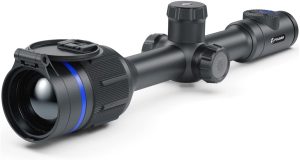
The use of thermal scopes is controlled by each state individually and in some states, they are outright banned, or night hunting is not permitted, and others control the time of year and what species they can be used for. Be certain to check your state for restrictions. From the research I’ve done, they are legal in 40 of the 50 states, with Alaska, Arizona, California, Colorado, Hawaii, Nevada, New Mexico, Oregon, Tennessee, and Utah either not allowing their use specifically or not permitting night hunting at all. This list is certainly subject to change.
Where legal, however, these scopes are being used primarily at night for hunting hogs and coyotes, although not exclusively. Thermal scopes differ from infrared in the fact that no light is emitted, making them legal in some states where IR scopes are banned.
The Pulsar Thermion 2 XP50 Pro has all the bells and whistles and a price tag to match, at around $5,000. But it isn’t short on features and Pulsar bills it as the first thermal imaging riflescope with a classic design and built-in laser rangefinder. I’m still not 100% sold on the need for a built-in laser rangefinder, however. Determining distance can be extremely challenging with thermals and image quality degrades severely after about 200 yards, so you may not always be able to positively identify your target at longer ranges. The scope boasts a detection range of 1,800 meters, and unquestionably, it will display targets at that range, but there’s no way you could determine a buck from a doe or perhaps even a coyote from a fox, so bear that in mind when looking at different models.
But if you need or even want all the bells and whistles, then the Pulsar Thermion 2 XP50 Pro delivers. It features a massive 640×480 sensor with 2-16 magnification and a high contrast 1024×768 HD AMOLED display. You won’t find a clearer thermal scope and with a 2-16x zoom range, it is set up for taking shots from close up and personal to several hundred yards or more away. It even has a built-in camera that takes both pictures and video. It also offers 10 reticle shapes in nine colors and five unique shooting profiles to cover all weather conditions. You can even use Bluetooth on your smartphone to change the settings or share your view with your hunting partner. Advanced technology abounds in this scope.
Pros
- Mounts with regular 30mm rings
- Massive 640×480 sensor
- High contrast 1024×768 HD AMOLED display
- Built-in laser range finder
- Wi-Fi and Bluetooth connectivity
- Built-in photo and video recording
Cons
- At around $5,000 it is expensive
- It is heavy at 34.22 ounces without battery
As you can see, there are a number of great scope manufacturers out there these days, offering a wide variety of features, and the great thing is, there’s one to match everyone’s budget. But what questions should I ask myself before buying?
FAQ on Selecting the Best Rifle Scopes
1) What is my realistic budget?
-
- Your realistic budget depends on your hunting or shooting needs, as well as how often and where you plan to use your scope. Based on the article:
- Under $500: Ideal for casual weekend hunters or those just starting out. Scopes like the Vortex Diamondback 3-9×40 offer reliable performance at a great value for general hunting needs.
- $500–$800 (Mid-Range): Best for hunters who want enhanced optical quality and some advanced features without breaking the bank. Scopes like the Meopta Optika6 3-18×50 BDC-3 Illuminated SFP provide impressive versatility and clarity.
- Under $1,000: For those looking for a balance between affordability and premium features. The Riton 5 Primal 2-12×44 IR is a great choice for serious hunters wanting excellent glass and light transmission.
- $1,000+ (Premium): High-end scopes like the Zeiss Conquest V4 4-16×44 or Leica Amplus 6 3-18×44 deliver exceptional performance, clarity, and durability. These are suited for hunters needing precision at longer ranges or in challenging environments.
- Specialty & Electronic Scopes: If you require advanced features like thermal imaging or integrated rangefinders, consider scopes like the Pulsar Thermion 2 XP50 Pro ($5,000) or electronic scopes like the Burris Eliminator 6 4-20x52mm ($3,000).
- Your realistic budget depends on your hunting or shooting needs, as well as how often and where you plan to use your scope. Based on the article:
2) What magnification ranges best suit my style of hunting?
-
-
-
- The best magnification range depends on your hunting environment, target species, and typical shooting distances. Here’s how the article breaks it down:
- Close-Range Hunting (Thick Woods, Brushy Areas, or Dangerous Game):
- Magnification: 1x to 4x
- Examples: Hawke Vantage IR 1-4×20 (great for turkey hunting), Trijicon Credo HX 1-8×28 (ideal for dangerous game with fast target acquisition), and Leupold VX Freedom 1.5-4×28 (perfect for lever-action rifles in close quarters).
- Why: Lower magnification provides a wide field of view for quick target acquisition in dense environments.
- Mid-Range Hunting (General Big Game, Deer in Mixed Terrain):
- Magnification: 3x to 9x
- Examples: Vortex Diamondback 3-9×40, Swarovski Z3 3-9×36 (lightweight for mountain rifles).
- Why: Versatile enough for most hunting scenarios, allowing accuracy up to 300 yards.
- Long-Range Hunting (Open Plains, Mountain Hunts):
- Magnification: 4x to 16x or 3x to 18x
- Examples: Zeiss Conquest V4 4-16×44, Meopta Optika6 3-18×50, Leica Amplus 6 3-18×44.
- Why: Higher magnification allows precision at longer distances, often required for mule deer, elk, or sheep in wide-open spaces.
- Extreme Long-Range Shooting or Precision Hunting:
- Magnification: 5x to 25x or higher
- Examples: Zeiss LRP S5 5-25×56, Nightforce NXS 5.5-22×50.
- Why: Perfect for precision shooting or targeting game at extreme ranges (500+ yards) in open environments.
- Specialized Situations (Thermal or AR Hunting):
- Magnification: 1x to 8x or variable with additional features.
- Examples: Pulsar Thermion 2 XP50 Pro (thermal with 2x-16x), Aimpoint Comp 5 (red dot with 2 MOA dot for fast shooting).
- Why: Thermal scopes or red dots are excellent for hogs, predators, or tactical-style shooting in close-to-mid-range scenarios.
- Close-Range Hunting (Thick Woods, Brushy Areas, or Dangerous Game):
- The best magnification range depends on your hunting environment, target species, and typical shooting distances. Here’s how the article breaks it down:
-
-
3) Do I need some sort of ballistic compensation?
-
- The need for ballistic compensation depends on the type of hunting or shooting you do and the distances you typically shoot. Here’s what the article suggests:
You Need Ballistic Compensation If:
- You Hunt or Shoot at Long Ranges (300+ Yards):
- Examples: Elk, mule deer, or sheep in open plains or mountain terrain.
- Recommended Scopes:
- Zeiss Conquest V4 4-16×44: Offers 80 MOA elevation adjustment and an exposed MOA turret for precise elevation adjustments.
- Leica Amplus 6 3-18×44: Features a ballistic reticle with windage compensation.
- Nightforce NXS 5.5-22×50: Includes elevation and windage turrets for fine adjustments.
- You Want to Simplify Long-Range Shooting:
- Built-in ballistic reticles or turrets help account for bullet drop and windage without guesswork.
- Examples:
- Burris Eliminator 6 4-20x52mm: Features built-in laser rangefinding and automatic ballistic compensation.
- Zeiss LRP S5 5-25×56: Offers both MOA and MR reticle options with precise ballistic adjustments.
- You Shoot with Specialized Loads:
- Precision and handloads may require detailed compensation for bullet trajectory.
- Scopes with customizable ballistic calculators like the Maven CRS.1 3-12×50 are ideal.
You Might Not Need Ballistic Compensation If:
- You Hunt Primarily at Close Ranges (Under 300 Yards):
- In thick woods or brush, shots are often short and don’t require compensation for bullet drop.
- Recommended Scopes:
- Hawke Vantage IR 1-4×20: Great for turkey hunting.
- Leupold VX Freedom 1.5-4×28: Perfect for lever-action rifles.
- You Use a Simple Setup:
- If your shooting style or rifle is straightforward, basic scopes like the Riton 3 Primal 3-9×40 EER or Vortex Diamondback 3-9×40 work well.
- You Hunt or Shoot at Long Ranges (300+ Yards):
- The need for ballistic compensation depends on the type of hunting or shooting you do and the distances you typically shoot. Here’s what the article suggests:
4) Do I want a first or second focal plane scope?
-
- Choosing between a first focal plane (FFP) and a second focal plane (SFP) scope depends on your shooting style, typical range, and personal preferences. Here’s what the article highlights:
First Focal Plane (FFP) Scopes:
- Best For:
- Long-range shooters or precision hunters who frequently adjust for bullet drop and windage at varying magnifications.
- Scenarios where you need consistent holdovers regardless of magnification.
- Key Features:
- The reticle size adjusts with magnification, ensuring the holdover points remain accurate at all levels.
- Ideal for extreme long-range or competition shooting where precision is critical.
- Recommended Scopes:
- Zeiss LRP S5 5-25×56: Designed for precision target shooting with a consistent ballistic reticle.
- Bushnell Match Pro ED 3-18×50: Excellent for budget-conscious long-range hunters, featuring an FFP reticle.
- Considerations:
- Reticles can be hard to see at lower magnifications, especially in dense cover.
- Typically more expensive than SFP scopes.
Second Focal Plane (SFP) Scopes:
- Best For:
- Most hunters, particularly those shooting at fixed or closer ranges (under 500 yards).
- Scenarios where you prefer a reticle that remains the same size regardless of magnification.
- Key Features:
- Reticle does not change size as you zoom, making it easier to see at lower magnifications.
- Popular for general-purpose hunting and mid-range shooting.
- Recommended Scopes:
- Zeiss Conquest V4 4-16×44: A versatile scope for both mountain and deer woods hunting.
- Meopta Optika6 3-18×50: Excellent choice for hunters who want simplicity and reliability.
- Vortex Diamondback 3-9×40: A budget-friendly option for casual big-game hunters.
- Considerations:
- Holdover points are accurate only at a specific magnification (usually the highest).
- Simpler to use, making them ideal for hunters who prefer quick, hassle-free adjustments.
Which Should You Choose?
- Choose FFP if you:
- Frequently shoot long distances.
- Require accurate holdovers at varying magnifications.
- Participate in competitive shooting or precision-based hunting.
- Choose SFP if you:
- Primarily hunt at close to mid-range distances.
- Prefer a simple, consistent reticle for quick targeting.
- Value affordability and ease of use over advanced features.
For most hunters, a second focal plane scope will suffice unless you specialize in long-range or technical shooting.
- Best For:
- Choosing between a first focal plane (FFP) and a second focal plane (SFP) scope depends on your shooting style, typical range, and personal preferences. Here’s what the article highlights:
5) Do I want an illuminated reticle?
- Deciding whether you need an illuminated reticle depends on your hunting environment, light conditions, and shooting preferences.
You Might Want an Illuminated Reticle If:
- You Hunt in Low-Light Conditions:
- Early mornings, late evenings, or dense woods often require enhanced reticle visibility.
- Examples:
- Zeiss Conquest V4 4-16×44: Offers an illuminated reticle option for better visibility in the shoulder hours.
- Athlon Midas HMR 2.5-15×50: Includes a simple illuminated BDC reticle, ideal for whitetails in varying light.
- You Need Quick Target Acquisition:
- An illuminated reticle is particularly useful for fast-moving targets or situations where precise aim is crucial.
- Examples:
- Hawke Vantage IR 1-4×20: Designed for turkey hunting with a bright, easy-to-see dot.
- Trijicon Credo HX 1-8×28: Features red or green illumination for rapid aiming in thick cover or dangerous game hunting.
- You Shoot at Distant or Precision Targets:
- Illuminated reticles with fine dots or Christmas tree designs help pinpoint targets at long range.
- Examples:
- Burris Eliminator 6 4-20x52mm: Illuminates the exact point of aim for accurate ballistic compensation.
- Bushnell Match Pro ED 3-18×50: Reticle illumination supports clarity in competition or long-range hunts.
You Might Not Need an Illuminated Reticle If:
- You Hunt in Daylight or Open Areas:
- In bright, clear conditions, a standard reticle is usually sufficient.
- Examples:
- Vortex Diamondback 3-9×40: Perfect for general-purpose daylight hunting.
- Swarovski Z3 3-9×36: A lightweight scope designed for mountain and field use without illumination.
- You Prefer Simplicity:
- If you prioritize straightforward functionality and minimal features, an illuminated reticle may feel unnecessary.
- Examples:
- Leupold VX Freedom 1.5-4×28: A classic, no-frills scope for lever guns and close-range hunting.
- You Want to Save on Weight and Battery Dependency:
- Illumination systems add a small amount of weight and rely on batteries, which could fail during a hunt.
Which Should You Choose?
- Yes, to illuminated reticle: If you hunt in low-light conditions, dense cover, or require quick, precise targeting.
- No, to illuminated reticle: If your hunting is primarily during daylight hours or you prefer simplicity.
For most hunters, an illuminated reticle is a useful feature, but it’s not essential unless your environment or hunting style demands it.
- You Hunt in Low-Light Conditions:
6) How important is weight as a consideration?
- Weight is a critical factor when choosing a rifle scope, especially for specific types of hunting. Here’s how the article helps evaluate its importance:
Weight Is Very Important If:
- You Hunt in the Mountains or Backcountry:
- Long hikes, steep climbs, and challenging terrain make every ounce count.
- Lightweight scopes reduce overall rifle weight, improving maneuverability and reducing fatigue.
- Examples:
- Swarovski Z3 3-9×36: Ultra-light at just 12 ounces, perfect for lightweight mountain rifles.
- Leupold VX Freedom 1.5-4×28: Weighing only 9.6 ounces, ideal for lever guns and heavy timber hunting.
- You Use an Ultralight Rifle:
- A heavy scope can throw off the balance of a lightweight rifle, reducing ease of handling.
- Look for scopes under 20 ounces to maintain rifle balance.
- You Prioritize Portability:
- For spot-and-stalk hunters or those who travel long distances, a lighter scope adds convenience without sacrificing performance.
Weight Is Less Important If:
- You Hunt From a Stand or Blind:
- If your hunting involves minimal movement, scope weight matters less.
- Examples:
- Zeiss LRP S5 5-25×56: Heavy at 36.3 ounces but perfect for long-range shooting from a fixed position.
- Pulsar Thermion 2 XP50 Pro: Weighing 34.22 ounces, this thermal scope is feature-packed for stationary hog or predator hunting.
- You Use a Sturdy, Heavy Rifle, or are target shooting from a bench:
- Larger rifles can handle heavier scopes without becoming unbalanced.
- Examples:
- Nightforce NXS 5.5-22×50: At 31 ounces, this scope is ideal for precision shooting with heavier rifles.
- You Need Advanced Features:
- Features like large objective lenses, first focal plane reticles, or electronic components often add weight but improve performance.
- Examples:
- Burris Eliminator 6 4-20x52mm: Heavy at 30 ounces due to built-in rangefinder and ballistic compensation.
- Bushnell Match Pro ED 3-18×50: Lightweight for its feature set but still a bit heavier at 27 ounces.
- You Hunt in the Mountains or Backcountry:
7) What should be considered if the primary use is hunting versus shooting competitions?
Your choice of scope will vary significantly depending on whether your primary focus is hunting or shooting competitions. Here’s what to consider based on the article:
If the Primary Use Is Hunting:
- Lightweight and Compact Design:
- Mobility and comfort are critical for hunters who cover long distances or handle their rifles frequently.
- Examples:
- Swarovski Z3 3-9×36: Ultra-light and ideal for mountain or backcountry hunting.
- Leupold VX Freedom 1.5-4×28: Compact and lightweight for lever guns or close-range hunting.
- Magnification Range:
- Match the magnification range to the terrain and game species:
- Close-Range Hunting: 1x-4x for thick woods or dangerous game.
- Mid-Range Hunting: 3x-9x or 3x-12x for deer in mixed terrain.
- Long-Range Hunting: 4x-16x or 5x-25x for open plains or mountain hunting.
- Match the magnification range to the terrain and game species:
- Durability and Weather Resistance:
- Scopes need to withstand harsh weather, impacts, and rough handling.
- Examples:
- Zeiss Conquest V4 4-16×44: Rugged construction and water-resistant coatings.
- Nightforce NXS 5.5-22×50: Known for durability in extreme conditions.
- Simplicity and Quick Adjustments:
- Features like illuminated reticles, simple ballistic reticles, or capped turrets can make field adjustments easier without overcomplicating the scope.
- Examples:
- Athlon Midas HMR 2.5-15×50: Illuminated BDC reticle with quick adjustments for low-light hunting.
If the Primary Use Is Shooting Competitions:
- Precision and High Magnification:
- Competitive shooting often requires extreme accuracy at long ranges, so scopes with high magnification and precise adjustments are key.
- Examples:
- Zeiss LRP S5 5-25×56: Designed for PRS and NRL competitions, with excellent optical clarity and 140 MOA elevation adjustment.
- Bushnell Match Pro ED 3-18×50: Budget-friendly competition scope with first focal plane reticle and external elevation turret.
- First Focal Plane (FFP) Reticles:
- FFP reticles are essential for consistent holdovers and precision across varying magnifications.
- Example:
- Bushnell Match Pro ED 3-18×50: Features a competition-ready FFP reticle with advanced functionality.
- Advanced Features:
- Consider scopes with exposed turrets, zero stops, side parallax adjustments, and detailed reticles for ballistic compensation.
- Examples:
- Nightforce NXS 5.5-22×50: Offers precision windage and elevation turrets and side parallax adjustment.
- Burris Eliminator 6 4-20x52mm: Includes electronic ballistic compensation for long-range accuracy.
- Weight and Bulk:
- Weight is less of a concern for competition shooting but might matter if switching between matches or setups.
- Reticle Complexity:
- Competition scopes often have detailed tree-style reticles for precise holdovers and windage adjustments.
- Example:
- Bushnell Match Pro ED 3-18×50: MIL 2 reticle with multiple hold points.
Summary of Key Differences:
| Feature | Hunting | Shooting Competitions |
|---|---|---|
| Weight | Lightweight for mobility | Less critical, but balance is valued |
| Magnification | Moderate, based on range and terrain | High magnification for precision |
| Reticle Type | Simple, illuminated for quick aiming | Detailed FFP for precision |
| Durability | Weather-resistant and rugged | Sturdy but focused on precision |
| Adjustments | Quick and simple, often capped turrets | Precise with exposed turrets |
| Primary Focus | Practicality and ease of use | Accuracy and advanced features |
For hunting, prioritize practicality, durability, and portability. For competition shooting, focus on precision, advanced reticle features, and adjustability.
8) Do I want electronic features like built-in rangefinder and ballistic compensation?
- Deciding whether to include electronic features in your rifle scope depends on your hunting or shooting needs, budget, and the level of convenience you prefer.
You Might Want Electronic Features If:
- You Hunt or Shoot at Long Ranges:
- Built-in rangefinders and ballistic compensation can simplify adjustments for bullet drop and windage.
- Example:
- Burris Eliminator 6 4-20x52mm: Features an integrated laser rangefinder and automatic ballistic compensation, making long-range shots easier.
- You Hunt in Open Terrain:
- Electronic features are especially useful in wide-open spaces where range estimation can be challenging.
- Example:
- Pulsar Thermion 2 XP50 Pro: Combines thermal imaging with a rangefinder for precision in low-light or open conditions.
- You Prioritize Convenience:
- Electronics eliminate the need for separate rangefinders or manual ballistic calculations, saving time and simplifying your setup.
- Example:
- Burris Eliminator 6: Automatically calculates holdover and illuminates the exact point of aim.
- You Want the Latest Technology:
- Advanced scopes with Bluetooth connectivity or app integration allow real-time adjustments and data sharing.
- Example:
- Pulsar Thermion 2 XP50 Pro: Includes Bluetooth for remote control and data sharing.
You Might Not Want Electronic Features If:
- You Hunt in Short to Mid-Range Scenarios:
- For typical hunting ranges (under 300 yards), a simpler scope without electronics may suffice.
- Example:
- Vortex Diamondback 3-9×40: Reliable and straightforward for short to mid-range hunting.
- You Prefer Simplicity and Reliability:
- Electronic features can fail (e.g., battery depletion or malfunctions), which could be critical during a hunt.
- Example:
- Leupold VX Freedom 1.5-4×28: A classic, no-frills scope designed for durability.
- You’re on a Tight Budget:
- Electronic features typically add significant cost to a scope. If budget is a concern, focus on optical quality over gadgets.
- Example:
- Riton 3 Primal 3-9×40 EER: Budget-friendly without unnecessary features.
- You Hunt in Harsh Conditions:
- Extreme cold, moisture, or rugged environments can affect electronics. Traditional scopes are often more durable in tough conditions.
- You Hunt or Shoot at Long Ranges:
9) Do I prefer turrets or reticles for ballistic compensation?
- The choice between turrets and reticles for ballistic compensation depends on your shooting style, typical distances, and personal preference. Here’s how to decide based on the article:
Turrets for Ballistic Compensation:
- Best For:
- Precision shooters and long-range hunters who want exact adjustments for elevation and windage.
- Situations where you need to dial in specific settings for consistent accuracy at varying distances.
- Key Features:
- Exposed Turrets: Allow for quick adjustments in the field or at the range.
- Zero Stop: Ensures you can return to your baseline zero quickly after adjustments.
- Advantages:
- Precise and repeatable adjustments for elevation and windage.
- Allows for custom settings tailored to your specific ammunition and environmental conditions.
- Disadvantages:
- Takes more time to adjust compared to using holdover points on a reticle.
- May be more complex for hunters who need fast shots.
- Recommended Scopes:
- Zeiss Conquest V4 4-16×44: Features exposed MOA elevation turret and a zero stop for precise elevation adjustments.
- Nightforce NXS 5.5-22×50: Offers excellent elevation and windage turrets with a zero stop for long-range precision.
Reticles for Ballistic Compensation:
- Best For:
- Hunters or shooters who want simplicity and speed in the field.
- Situations where you need to make fast shots without adjusting external controls.
- Key Features:
- Holdover Points: Markings on the reticle for elevation and windage compensation.
- Illumination: Some reticles include illuminated markings for better visibility in low light.
- Advantages:
- Faster to use in hunting scenarios where quick adjustments are necessary.
- No moving parts to adjust, reducing complexity and potential for errors.
- Disadvantages:
- Less precise than turrets, especially for extreme long-range shooting.
- Requires understanding your reticle and practicing to know your holdover points at different ranges.
- Recommended Scopes:
- Meopta Optika6 3-18×50: Features a BDC reticle for simplified ballistic compensation.
- Athlon Midas HMR 2.5-15×50: Includes an illuminated BDC reticle that’s easy to use in hunting scenarios.
- Burris Eliminator 6 4-20x52mm: Automatically calculates holdover and illuminates the reticle point of aim.
Which Should You Choose?
- Choose Turrets If You:
- Prioritize precision and repeatability, especially for long-range or target shooting.
- Have the time to dial in adjustments and ensure exact shot placement.
- Examples: Long-range hunters, precision shooters, or PRS/NRL competitors.
- Choose Reticles If You:
- Want simplicity and speed for hunting scenarios.
- Often shoot at varying distances without time to adjust turrets.
- Examples: Big-game hunters, whitetail hunters, or those hunting in thick cover.
- Best For:



